Stocking rates of 450 juveniles per cubic meter make RAS shrimp systems profitable

In the last few decades, production of the Pacific white shrimp (Litopenaeus vannamei) has been negatively affected by disease epizootics and environmental concerns over the impacts of nutrient-rich effluent discharges into coastal waters. Traditional shrimp growout methods use outdoor ponds and substantial exchanges of pond water during the production cycle. The possible introduction of disease with incoming water and the release of pollutants have forced the industry to seek more sustainable management practices.
Limited-discharge systems
Limited-discharge recirculating aquaculture systems (RAS) can reduce disease introduction and the potential environmental impacts created by traditional pond culture. In a 92-day grow-out study conducted in 2007, four 40-cubic-meter greenhouse-enclosed, lined raceways were filled with water previously used in a 78-day nursery study. The raceways were stocked with 1.14-gram juvenile Pacific white shrimp at a density of 530 per cubic meter and operated with no water exchange.
To control particulate matter, two raceways were each outfitted with a homemade foam fractionator, and the other two were each equipped with a cylindroconical settling tank with a 4.9-cubic-meter working water volume operated on a continuous basis. Due to the large size of the fractionators and their ability to quickly reduce particulate load, they were only operated for a few days at a time.
The average weight of the shrimp raised in the raceways operated with settling tanks was 18.45 grams, significantly higher than the 17.35-gram weight of those raised in the raceways with foam fractionators. However, no statistically significant difference was found in total yield, survival or growth between the two treatments, although an impressive total yield of 9.29 kg per cubic meter was found in one of the raceways operated with a settling tank.
The differences in mean final weight between treatments were likely the result of the intermittent operation of the foam fractionators, which produced fluctuations in the concentration and availability of biofloc as an additional food source.
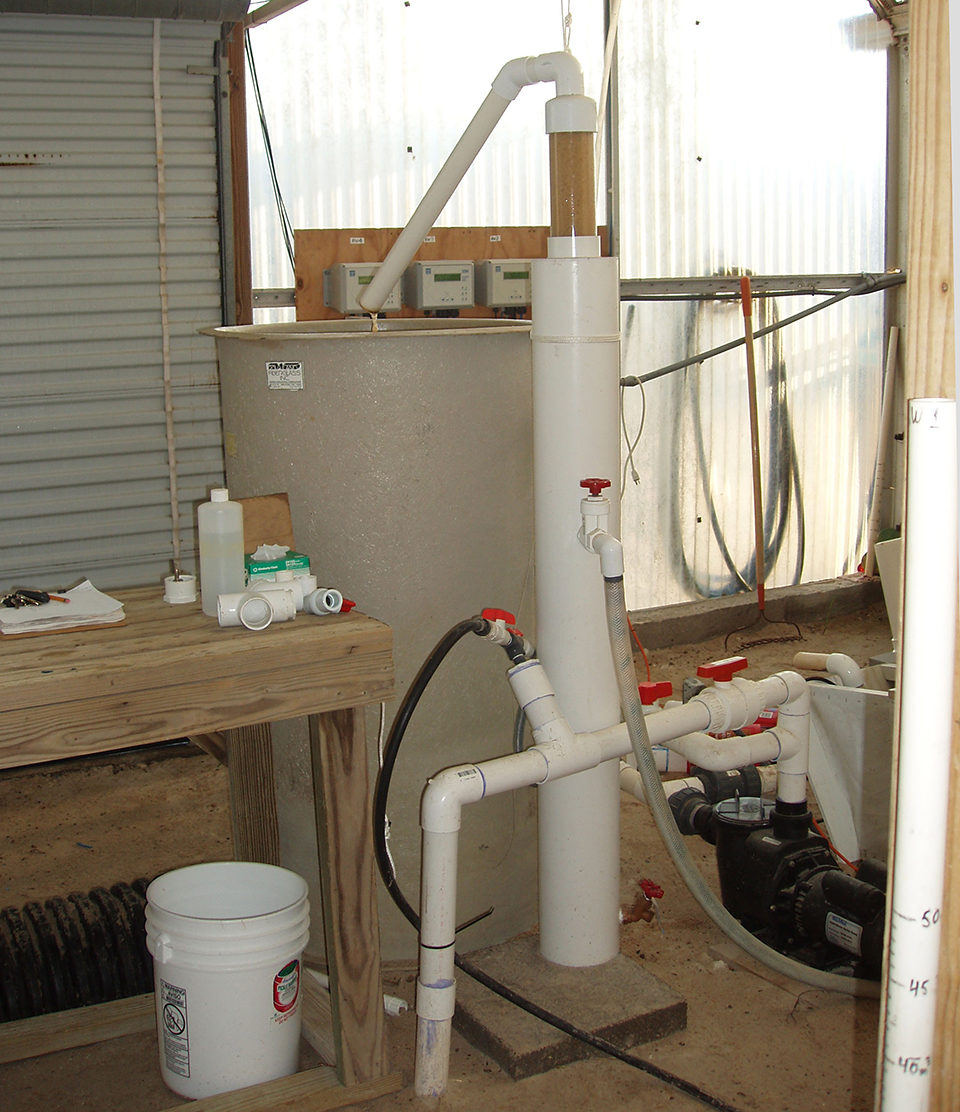
Follow-up study
In 2009, a 108-day follow-up study was conducted to determine whether operating raceways in a system with smaller fractionators would minimize differences in final shrimp weights in comparison to shrimp raised in raceways operated with settling tanks. Funding was provided by the United States Department of Agriculture (USDA) Cooperative State Research, Education and Extension Service; USDA Marine Shrimp Farming Program; U.S. Agency for International Development; National Academy of Sciences and Texas AgriLife Research.
The study was conducted in the same four 40-cubic-meter raceways as used previously. Each raceway was equipped with a longitudinal center partition positioned over a polyvinyl chloride pipe with spray nozzles directed along the raceway bottom. Each raceway had banks of three 5.1-cm airlift pumps positioned on both sides of the partition. In addition, each raceway had six air diffusers, a centrifugal pump and a Venturi injector capable of mixing the culture water with atmospheric air or a mixture of oxygen and air.
The raceways were filled with water used in a preceding 62-day nursery study. Two raceways were each outfitted with a small commercial foam fractionator, while the other two raceways were each equipped with one of the settling tanks from the previous study. All four raceways were stocked at 450 shrimp per cubic meter with juvenile Pacific white shrimp weighing 0.99 ± 0.17 grams from the nursery trial.
The shrimp were fed four times daily with a commercial 35 percent-crude protein feed specially formulated for intensive systems operated with limited water exchange. For the first week of the trial, this feed was mixed with the feed used in the previous nursery trial for a smooth transition to the new feed. From day 19 on, two-thirds of the ration were fed in four equal portions during the day, while the remainder was fed throughout the night using belt feeders. Daily rations were adjusted based on an assumed feed-conversion ratio of 1:1.4, weekly growth of 1.4 grams and weekly mortality of 0.5 percent.
To control particulates, use of the settling tanks and fractionators was initiated 23 days after the study began. Both were operated intermittently, targeting total suspended solids (TSS) concentrations in the culture water of 400-500 mg/L and settleable solids of 10-14 mL/L. Water flow into the settling tanks varied 2-6 L/minute. Raceways were maintained with zero water exchange throughout the study. Municipal freshwater was added to compensate for water loss due to evaporation and operation of the foam fractionators.
Water temperature, salinity, dissolved oxygen (D.O.) and pH were monitored twice daily using a multiprobe. Alkalinity and settleable solids were monitored every two to three days. Other parameters were checked weekly.
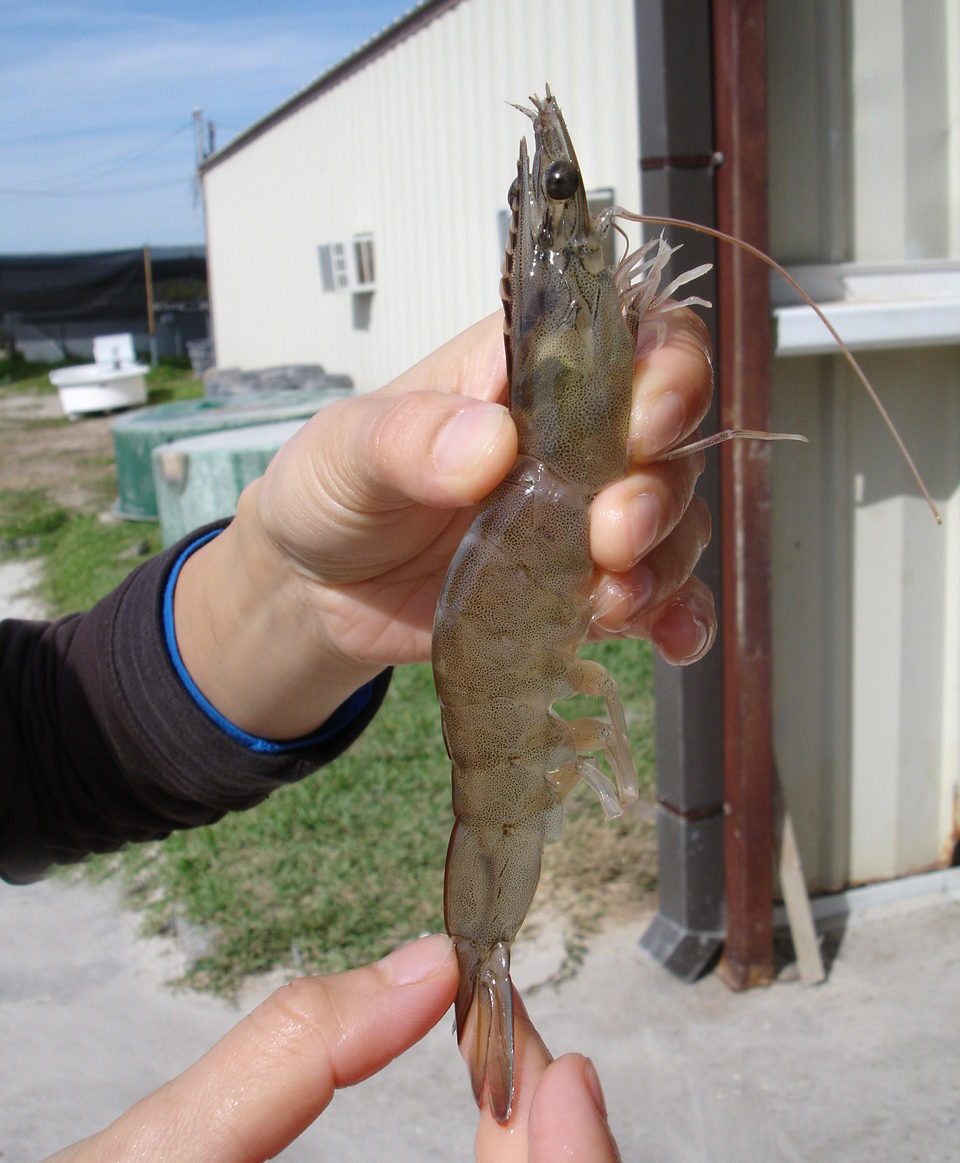
Water quality
Alkalinity and pH were controlled by adding sodium bicarbonate, targeting an alkalinity of 160 mg/L calcium carbonate. Each raceway was equipped with a multi-parameter monitoring system that uploaded data to a computer in the lab, which could also be accessed from remote locations for real-time monitoring of D.O. levels.
Oxygen supplementation did not begin until day 68 of the study. For a period of 40 days, the oxygen was used only intermittently for 30 to 60 minutes at a flow rate of 1.0 L/minute following the daytime feeding and only if D.O. levels dropped below 3 mg/L. During the final week, pure oxygen was constantly mixed with ambient air at a flow rate of 0.3-0.5 L/minute.
Results
Although alkalinity in the raceways was readjusted at least twice a week, the 124 ± 17 mg/L calcium carbonate mean alkalinity in the units operated with fractionators was significantly lower than the 129 ± 14 value in the raceways operated with settling tanks. Aside from this, no other difference was found between treatments in the daily water quality indicators monitored (Table 1).
Samocha, Mean values (± standard error), Table 1
| Treatment | Temperature (° C) a.m. | Temperature (° C) p.m. | Dissolved Oxygen (mg/L) a.m. | Dissolved Oxygen (mg/L) p.m. | pH a.m. | pH p.m. | Salinity (ppt) |
|---|
Treatment | Temperature (° C) a.m. | Temperature (° C) p.m. | Dissolved Oxygen (mg/L) a.m. | Dissolved Oxygen (mg/L) p.m. | pH a.m. | pH p.m. | Salinity (ppt) |
|---|---|---|---|---|---|---|---|
| Raceways with fractionators | 29.0 ± 1 .5 | 29.7 ± 1.6 | 5.2 ± 0.5 | 4.7 ± 0.5 | 6.9 ± 0.2 | 6.8 ± 0.2 | 30.3a ± 0.5 |
| Raceways with settling tanks | 28.8 ± 1.6 | 29.6 ± 1.7 | 5.2 ± 0.4 | 4.8 ± 0.5 | 6.9 ± 0.2 | 6.8 ± 0.2 | 30.8b ± 0.5 |
Statistical analyses of the weekly water quality indicators showed significantly higher nitrate-nitrogen levels in the raceways operated with fractionators (Table 2). Furthermore, the nitrate-nitrogen on the day of termination in the raceways operated with fractionators reached an average concentration of 457 mg/L, while the concentration in those with settling tanks was only 358 mg/L.
Samocha, Mean values (± standard error), Table 2
| Treatment | TAN | NO2-N | NO3-N | cBOD5 Alk. (mg/L | cBOD5 Alk. (mg/L | TSS | VSS | R.P. | S.S. (mL/L) | Turb (NTU) |
|---|
Treatment | TAN | NO2-N | NO3-N | cBOD5 Alk. (mg/L | cBOD5 Alk. (mg/L | TSS | VSS | R.P. | S.S. (mL/L) | Turb (NTU) |
|---|---|---|---|---|---|---|---|---|---|---|
| Raceways with fractionators | 0.17 ± 0.20 | 0.35 ± 0.27 | 267a ± 114 | 25 ± 7 | 24a ± 17 | 502 ± 157 | 236 ± 107 | 17 ± 7 | 15 ± 6 | 219 ± 35 |
| Raceways with settling tanks | 0.16 ± 0.15 | 0.30 ± 0.25 | 220b ± 84 | 27 ± 10 | 129b ± 14 | 434 ± 120 | 202 ± 91 | 17 ± 7 | 14 ± 7 | 213 ± 32 |
TAN = Total ammonia nitrogen
NO2-N = Nitrite-nitrogen
NO3-N = Nitrate-nitrogen
cBOD5 = Carbonaceous five-day biochemical oxygen demand
Alk. = Alkalinity
TSS = Total suspended solids
VSS = Volatile suspended solids
R.P. = Reactive phosphorus
S.S. = Suspended solids
Turb. = Turbidity
The lower concentration can be attributed to some denitrification that took place at the anaerobic sludge-water interface in the bottoms of the settling tanks. No other difference was found between treatments in the weekly water quality indicators monitored in this study. Total ammonia nitrogen and nitrite-nitrogen levels in all four raceways remained very low throughout the study.
Bacterial floc and algae were found in the culture medium throughout the study. Settleable solids reached a concentration of 33 mL/L in one raceway on day 43, but for the most part, concentrations ranged 10-30 mL/L. Although a TSS concentration of 790 mg/L was recorded on one occasion, concentrations generally stayed within the targeted 400-500 mg/L range. A large portion of the TSS was in the form of volatile suspended solids. No signs of bacterial infection were found during this trial.
The study suggested that a shrimp biomass load of about 7.5 kg per cubic meter can be maintained with only occasional oxygen supplementation. The real-time D.O. data provided was a valuable tool for the management of this system and allowed the use of far less oxygen than in previous trials.
Data obtained at harvest showed no statistically significant differences between the 21.8, and 22.5-gram final mean shrimp weights between treatments (Table 3). Survival rates in all raceways were above 94.5 percent. Shrimp growth varied 1.35-1.39 g/week. Feed-conversion ratios varied between 1.53 and 1.60. Shrimp yield varied 9.34-9.75 kg per cubic meter. Water use in the raceways varied from 98-126 L/kg shrimp produced.
Samocha, Summary of final means for shrimp performance, Table 3
| Treatment | Final Weight (g) | Growth (g/week | Yield (kg/m3) | Survival (%) | Feed-Conversion Ratio | Water Use (L/kg shrimp) |
|---|
Treatment | Final Weight (g) | Growth (g/week | Yield (kg/m3) | Survival (%) | Feed-Conversion Ratio | Water Use (L/kg shrimp) |
|---|---|---|---|---|---|---|
| Raceway 1 with settling tank | 21.96 | 1.36 | 9.34 | 94.54a | 1.60 | 126 |
| Raceway 4 with settling tank | 21.81 | 1.39 | 9.52 | 94.51a | 1.57 | 107 |
| Raceway 2 with fractionator | 22.51 | 1.35 | 9.51 | 96.86b | 1.53 | 108 |
| Raceway 3 with fractionator | 22.40 | 1.39 | 9.75 | 96.26b | 1.57 | 98 |
Economic analysis
An economic analysis based on study production results suggested that stocking rates of 450 juveniles per cubic meter, with survival above 90 percent, can make recirculating shrimp systems profitable, provided sales prices can cover production costs. The production results were combined with current input and output costs to simulate a commercial-scale operation.
The operation scale for this analysis included one greenhouse unit with eight 500-cubic-meter grow-out raceways, two 500-cubic-meter nursery raceways and appropriate equipment for a total initial investment of U.S. $992,000. The calculated variable cost of producing shrimp was $4.82/kg, and the fixed cost of production was $0.70/kg. Thus the total cost was $5.52/kg of shrimp produced.
The selling price for shrimp used in this simulation was U.S. $7.20/kg for 46-55 shrimp/kg (21-25 shrimp/lb). The feed cost was $1,095 per metric ton, and juveniles were valued at $19.52/1,000. Based on an expected 3.7 annual crops, there was a net return of $1.68/kg. The 10-year net value was $1.08 million for an internal rate of return of 32.8 percent with a 2.8-year period to cover the initial investment.
(Editor’s Note: This article was originally published in the July/August 2010 print edition of the Global Aquaculture Advocate.)
Now that you've reached the end of the article ...
… please consider supporting GSA’s mission to advance responsible seafood practices through education, advocacy and third-party assurances. The Advocate aims to document the evolution of responsible seafood practices and share the expansive knowledge of our vast network of contributors.
By becoming a Global Seafood Alliance member, you’re ensuring that all of the pre-competitive work we do through member benefits, resources and events can continue. Individual membership costs just $50 a year.
Not a GSA member? Join us.
Authors
-
Tzachi M. Samocha, Ph.D.
Texas AgriLife Research
AgriLife Research Mariculture Laboratory
4301 Waldron Road
Corpus Christi, Texas 78418 USA -
Joshua S. Wilkenfeld
Texas AgriLife Research
AgriLife Research Mariculture Laboratory
4301 Waldron Road
Corpus Christi, Texas 78418 USA -
Timothy C. Morris
Texas AgriLife Research
AgriLife Research Mariculture Laboratory
4301 Waldron Road
Corpus Christi, Texas 78418 USA -
Eudes S. Correia, Ph.D.
Universidade Federal Rural de Pernambuco
Recife, Pernambuco, Brazil -
Terry Hanson, Ph.D.
Department of Fisheries and Allied Aquacultures
Auburn University
Auburn, Alabama, USA
Tagged With
Related Posts
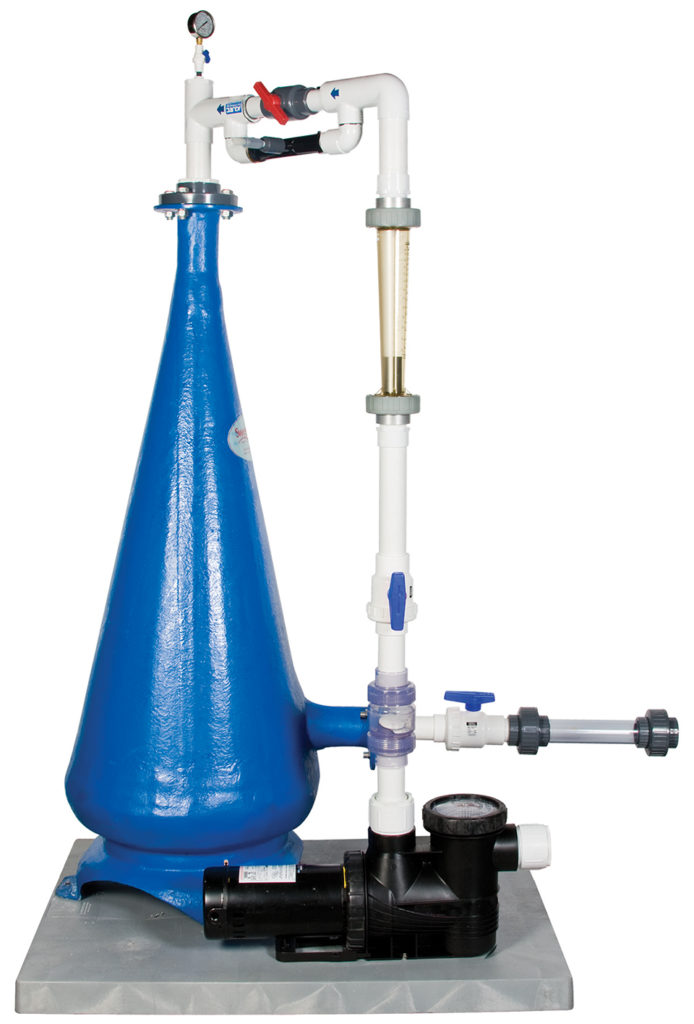
Responsibility
A look at unit processes in RAS systems
The ability to maintain adequate oxygen levels can be a limiting factor in carrying capacities for RAS. The amount of oxygen required is largely dictated by the feed rate and length of time waste solids remain within the systems.
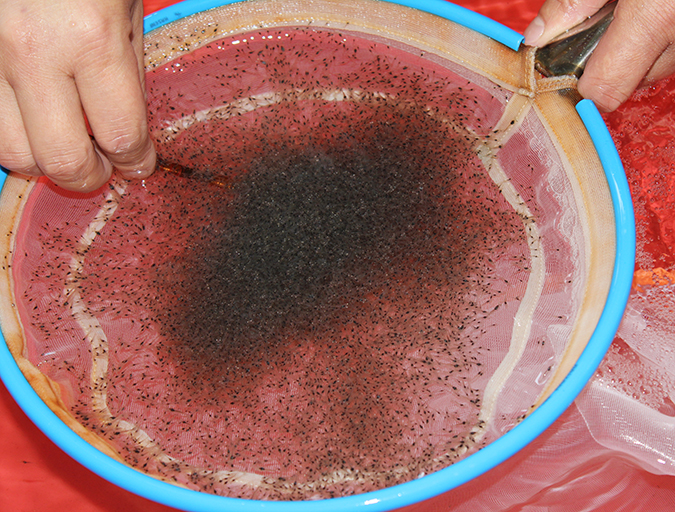
Health & Welfare
Acclimating shrimp postlarvae before pond stocking
Shrimp postlarvae acclimation before stocking into the various growout systems (ponds, raceways, tanks) is a critical – and often overlooked, sometimes taken for granted – step in the shrimp culture process. Various water quality parameters should be changed slowly so that the young shrimp have the time to gradually adapt to the new conditions.
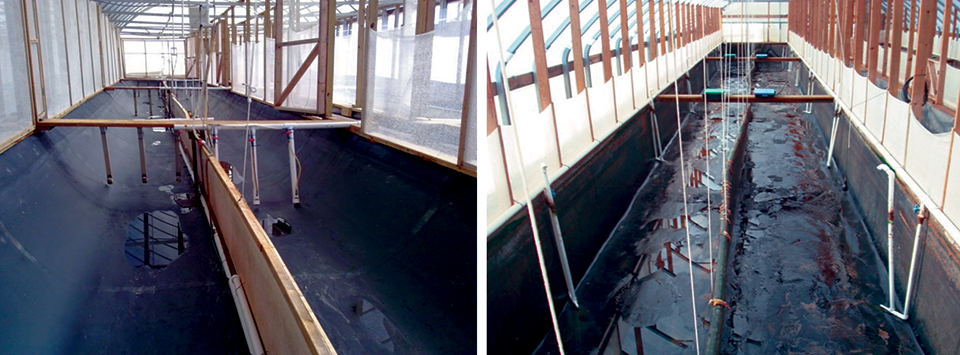
Responsibility
Advances in super-intensive, zero-exchange shrimp raceways
Research at the Texas AgriLife Research Mariculture Laboratory is investigating ways to improve the economic viability of super-intensive raceways for shrimp production.
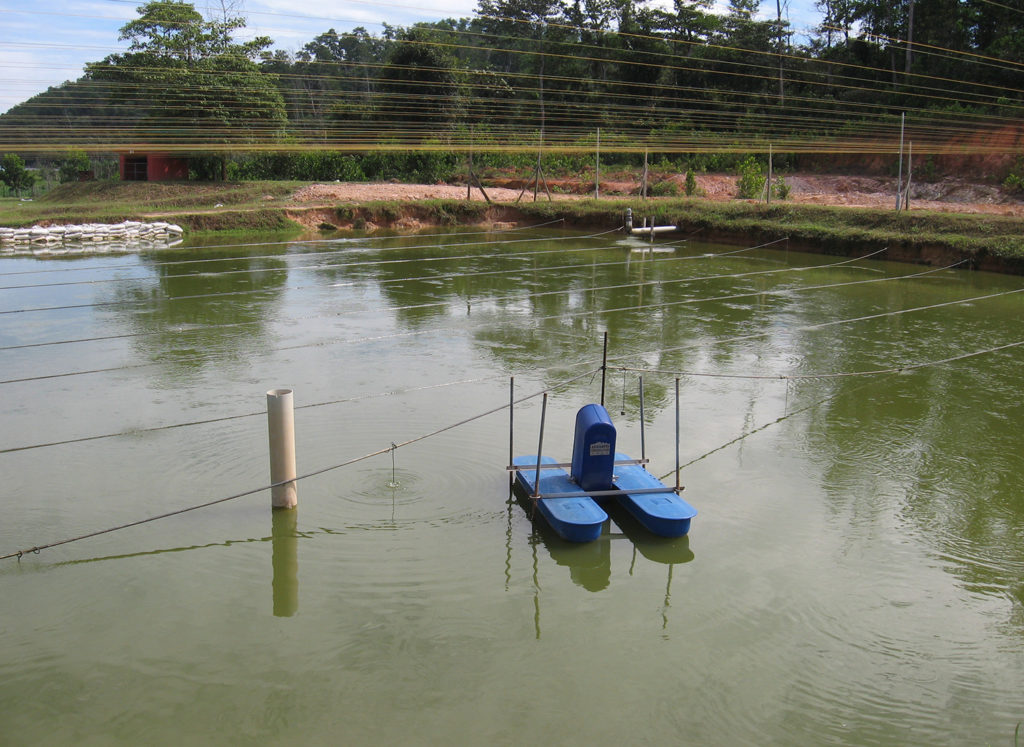
Health & Welfare
Advice for managing predatory birds, part 1
Predatory birds can cause major losses for tilapia farms. As some bird species are protected by law, fish farmers must use non-lethal control techniques.


